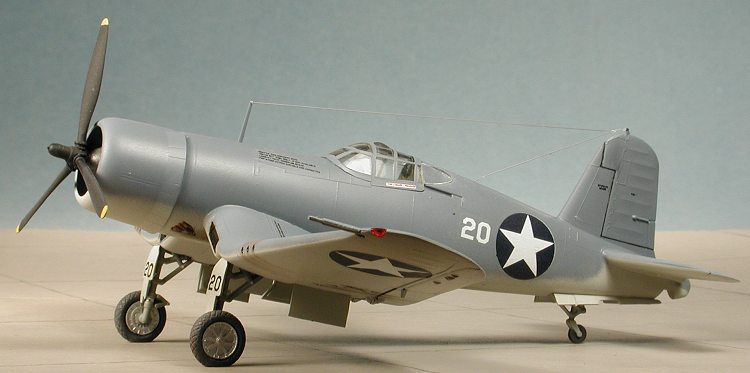
Hasegawa 1/72 F4U-1 Birdcage Corsair 'Pacific Aces Combo'
| KIT #: | 01946 |
| PRICE: | $19.99 on sale (39.99 SRP) |
| DECALS: | Three options |
| REVIEWER: | Scott Van Aken |
| NOTES: | Two complete kits |

| HISTORY |
The F4U Corsair was ordered in 1938 and became one of the most famous
fighter aircraft ever produced. It holds the distinction of having the
longest production run of any World War II US fighter, the last example not
being
delivered until late December 1952.
The The F4U-1 was the first model to be delivered to the Navy. The aircraft
featured a heavily framed canopy that restricted the pilot’s vision and had
handling characteristics they deemed unsuitable for a carrier based aircraft.
In spite of this, it was clear to the Navy that they had a capable gun platform
so the aircraft was farmed out to land based units until improvements in the
canopy and handling made is acceptable for carrier use. (Of course, the fact
that the British were very happy operating clipped-wing Corsairs from carriers
might have helped speed up this process a little....)
This original F4U-1 variant was known as the “birdcage” Corsair because of this
heavily framed canopy. The cockpit location resulted in poor visibility not
only in the landing phase, but also when the aircraft was being taxied on the
ground.
The canopy was modified part-way through the production run by creating a “bump”
in the plexiglas over the pilot’s head, allowing for better visibility during
taxi and landing operations. Because later Corsair variants built with “blown”
canopies officially shared the the same F4U-1 designation, it’s hard to
determine exactly how many birdcage variants were produced.
This variant was the first of the series to see battle, beginning operations at
Bougainville in February 1943 with VMF-124. VF-17 followed suit in March in New
Georgia.
| THE KIT |
 This is one of the last kits that Hasegawa designed with raised panel lines.
However, despite that, it is a very nice model and up to Hasegawa's standards of
the time. The grey plastic is very well molded and detailed. Cockpit consists of
seat, stick and instrument panel with decal for the instrument panel.
There is good main wheel well detail and none in the back. Engine is both rows
of cylinders with the second row molded on a backing plate. The canopy is in
several sections, but cannot be displayed open. Ejector pin marks are the
biggest problem with these pesky things on the inside of all the gear doors and
on the landing gear struts themselves. The ones on the wheels are going to be
nearly impossible to fill so aftermarket wheels are recommended.
This is one of the last kits that Hasegawa designed with raised panel lines.
However, despite that, it is a very nice model and up to Hasegawa's standards of
the time. The grey plastic is very well molded and detailed. Cockpit consists of
seat, stick and instrument panel with decal for the instrument panel.
There is good main wheel well detail and none in the back. Engine is both rows
of cylinders with the second row molded on a backing plate. The canopy is in
several sections, but cannot be displayed open. Ejector pin marks are the
biggest problem with these pesky things on the inside of all the gear doors and
on the landing gear struts themselves. The ones on the wheels are going to be
nearly impossible to fill so aftermarket wheels are recommended.

If you get the impression that this is a pretty basic kit, well, yes it is. There are aftermarket bits to help, specifically from True Details in terms of a nice resin cockpit and their 'flat' wheels. Squadron also does a vac canopy, but I'd steer away from it as my experience with Squadron vac canopies is that they lack proper frame definition. If you can get one of the Falcon sets that includes this canopy, then by all means get it as Falcon canopies are superbly done.
As implied by the box title, there are markings for three blue-grey over light grey USMC Corsairs. Two are shown on the box art. White 10 is 'Gus's Gopher' and flown by Lt. Wilbur Thomas with VMF-213 in July 1943. With a rather high grey on the fuselage is White 576 of Lt Edwin Olander in October 1943 with VMF-214. This one has some nose art and must have been a repaint as the light grey extends to the outer wings on the underside as well. Finally another VMF-213 plane, white 15, flown by Capt James Cupp in September 1943. This one is named 'Daphne C'. Decals are nicely done and the instructions are typical Hasegawa with Gunze paint references.
| CONCLUSIONS |
It isn't new, but makes into a very nice model when you are done. You can see from the image of a model built a dozen years back, that it is well done and well worth picking up.
| REFERENCES |

November 2013
Thanks to me for picking up this one.
If you would like your product reviewed fairly and fairly quickly, please contact the editor or see other details in the Note to Contributors.